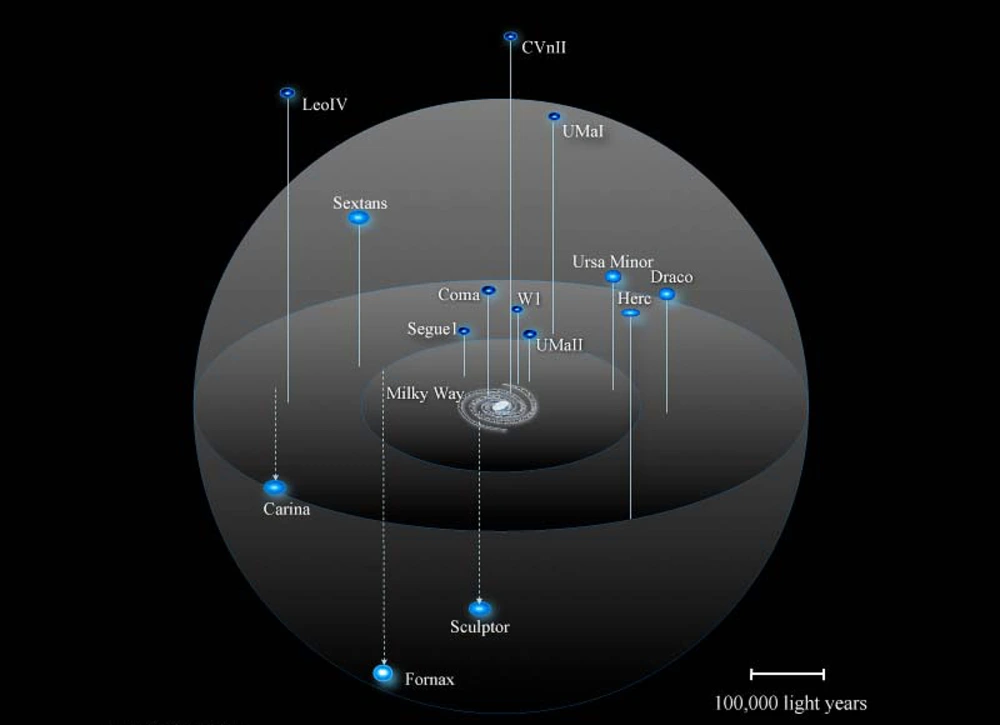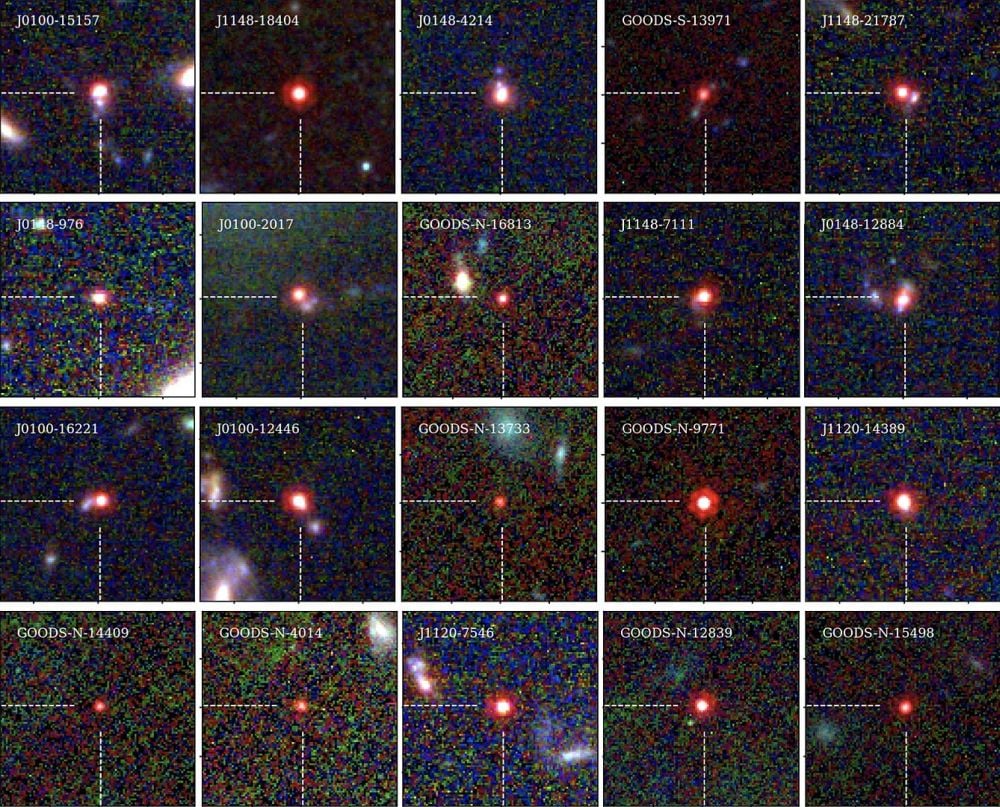A nearby dwarf galaxy could teach astrophysicists something new about dark matter and black holes. It's named Segue 1 and it's about 75,000 light years away. Segue 1 is one of the Milky Way's smallest and dimmest satellite galaxies. It has about 600,000 solar masses and is only as bright as about 300 Suns.
That means the tiny galaxy has a very high mass-to-light ratio, which suggests that it could be dominated by dark matter. But new research points in a different direction. It shows that rather than being held together by dark matter, a massive black hole at its center is keeping the tiny dwarf intact.
The research is titled "Modeling the “Dark-matter Dominated” Dwarf Galaxy Segue 1 with a Supermassive Black Hole," and it's published in The Astrophysical Journal Letters. The lead author is Nathaniel Lujan, a graduate student at the University of Texas at Austin.
"Dark matter and black holes play critical—and often overlapping—roles in galactic dynamics," the researchers write in their letter. Neither dark matter nor black holes emit light, but their combined massive gravitational strengths influence the light-emitting bodies in their vicinities: stars. So the motions and dynamics of stars tell astronomers a lot about black holes and dark matter.
But since both gravitational forces are present, it takes real effort to determine how the forces from a galaxy's black hole and dark matter are intertwined. "This work illustrates a dynamical modeling approach for disentangling these two influences in a subtle case, the dwarf galaxy Segue 1," the authors explain.
The nature of dark matter is mysterious because we don't know what it really is. Black holes are also mysterious, but less so. As the researchers point out, we know that almost all massive galaxies host a supermassive black hole in their centers. The lone known exception is M33. Astronomers think that dwarf galaxies and irregular galaxies may lack them.
"The dwarf spheroidal galaxy, Segue 1, is thought to have one of the largest ratios of dark matter to stellar mass," the authors write. That large component of unseen, dominant mass can be discovered by watching the way stars move. But the same thing is true of black holes. The researchers used models to try to understand how these forces are at play.
"Our work may revolutionize the modeling of dwarf galaxies or star clusters to include supermassive black holes instead of just dark matter halos," said Nathaniel Lujan, a graduate student at UTSA who led the research.
The work Lujan is referring to comes from a joint effort between University of Texas Austin and UT San Antonio. The two campuses ran an astronomy course that provided an opportunity for students from both campuses to work with powerful computers and advanced modelling aimed at studying how gravity affects galaxies. Astrophysicists Karl Gebhardt (UT Austin) and Richard Anantua (UTSA) ran the course together.
“We designed this course to foster collaboration between our two universities,” said Gebhardt. “Initially, the project was to model the gravitational dynamics inside Segue 1. That it resulted in a significant discovery is a real testament to the talent of these students and their determined, hard work.”
The students ran thousands of computer models of the motion of stars in Segue 1. The simulations were based on multiple factors, especially the mass of a black hole and the amount of dark matter. Their goal was to land on a model that could explain the motion of the dwarf galaxy's stars as observed by the Keck Observatory.
 *This image shows the Milky Way and several of its satellite dwarf galaxies, including Segue 1. Image Credit: J. Bullock/M. Geha/R. Powell*
*This image shows the Milky Way and several of its satellite dwarf galaxies, including Segue 1. Image Credit: J. Bullock/M. Geha/R. Powell*
Segue 1 is very close to the Milky Way, and our galaxy's gravity is stripping stars from the dwarf galaxy, mostly on the periphery. The first step was to determine which stars in the galaxy are moving because of the Milky Way's tidal stripping. Once those were identified, they were removed so as not to confuse the results.
From there, the researchers mapped the speeds and directions of the remaining stars. They found that stars in Segue 1's central region were whipping around the center in tight, fast circles. This is a clear sign that a black hole is present, and it was how scientists discovered the supermassive black hole in the Milky Way.
The models containing lots of dark matter didn't match what they were seeing. Models with both dark matter haloes and black holes came closer. The conclusion was clear: the spheroidal dwarf galaxy Segue 1 contained a black hole. "The preferred model has a central black hole and a dark halo," the authors write.
Finding a black hole didn't contradict everything astronomers know about dwarf galaxies. They've found black holes in some dwarf galaxies, but only a few percentage of them have confirmed black holes in their centers.
The size of the black hole is what's surprising.
Black holes in dwarf galaxies lie in the intermediate black hole (IMBH) mass range, somewhere between about 100 and 100,000 solar masses. But the black hole in Segue 1 is far more massive. The researchers estimate that it contains about 450,000 solar masses, exceeding the 100,000 solar masses of the galaxy's stars. In most of the galaxies we know of, the mass of the central black hole doesn't exceed that of the stars. In the Milky Way, for example, the SMBH has about 4.3 million solar masses, while the stars make up as much as 60 billion solar masses.
“There is a strong relation between the mass of the black hole and the mass of the host galaxy. The black hole in Segue 1 is significantly larger than what is expected,” explained Gebhardt. “If this large mass ratio is common among dwarf galaxies, we will have to rewrite how these systems evolve.”
What can explain the mass of Segue 1's black hole?
The researchers say that the tiny dwarf galaxy may have once had far more stars but lost them to the Milky Way by tidal stripping. What we see in the dwarf galaxy may be only the remnant of a once much larger galaxy. "Segue 1 is likely being tidally stripped at large radii, and we might be witnessing the remnant nucleus of a more massive system," the authors explain in their research letter.
Another intriguing possibility concerns "Little Red Dots" (LRD), a type of galaxy that the JWST found in the very early Universe. The majority of LRDs have accreting black holes that are much more massive than they should be, when compared to the LRDs overall mass. This mirrors what's observed in Segue 1. "Alternatively, given the high black hole mass relative to the stellar mass, Segue 1 is analogous to the Little Red Dots seen in the early Universe," the researchers explain.
 *This image shows some of the "Little Red Dots" discovered by the JWST. Segue 1 is very similar to them. Image Credit: "Little Red Dots: An Abundant Population of Faint Active Galactic Nuclei at z ∼ 5 Revealed by the EIGER and FRESCO JWST Surveys" Journal citation: Jorryt Matthee et al 2024 ApJ 963 129DOI: 10.3847/1538-4357/ad2345URL: https://iopscience.iop.org/article/10.3847/1538-4357/ad2345, CC BY 4.0, https://commons.wikimedia.org/w/index.php?curid=154052277*
*This image shows some of the "Little Red Dots" discovered by the JWST. Segue 1 is very similar to them. Image Credit: "Little Red Dots: An Abundant Population of Faint Active Galactic Nuclei at z ∼ 5 Revealed by the EIGER and FRESCO JWST Surveys" Journal citation: Jorryt Matthee et al 2024 ApJ 963 129DOI: 10.3847/1538-4357/ad2345URL: https://iopscience.iop.org/article/10.3847/1538-4357/ad2345, CC BY 4.0, https://commons.wikimedia.org/w/index.php?curid=154052277*
Segue 1 was once thought of as a dark matter dominated galaxy, but this research contradicts that. "The “dark-matter”-dominated galaxy Segue 1 has most of its mass in material that is dark," the authors write. "In this case, that material is primarily in the black hole as opposed to a standard dark halo."
The tiny, dim dwarf could be a relic LRD from the early Universe, and if that's the case, so could other dwarf spheroidal galaxies.
"It will be illuminating to carry out a similar investigation with other dwarf spheroidals," the authors conclude.

